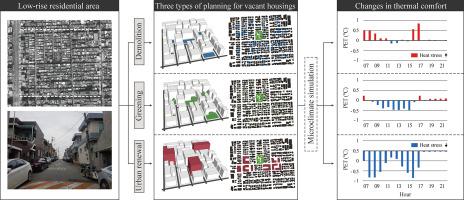Urban Climate ( IF 6.4 ) Pub Date : 2021-07-25 , DOI: 10.1016/j.uclim.2021.100924 Gukhwa Jang 1, 2 , Saehoon Kim 2, 3

|
Since the 20th century, shrinking cities have become a crucial subject in urban planning and public health literature. Given the growing concern about heat stress, a planning method for managing shrinking cities is increasingly linked with improvement of urban thermal comfort. The purpose of this study is to identify policy implications for developing so-called “decline-oriented strategies” that help to mitigate heat stress. The article assesses the effects of three strategies: 1) demolition strategy of abandoned houses, 2) demolition and greening the site strategy, and 3) small-scale urban renewal strategy. Using ENVI-met, we performed a comparative analysis of the differences in thermal comfort levels associated with each strategy. The results showed that the pre-post differences in thermal comfort were statistically significant for each strategy. Overall, the demolition strategy without greening elevated the surface temperature due to more extensive open areas without shade, forming a heat stress zone around vacant lots. The greening strategy partly offset the adverse effects of the demolition strategy by providing a thermally pleasant environment. Finally, the small-scale urban renewal strategy improved the thermal environment and provided a potential cooling zone, which pedestrians and residents could utilize.
中文翻译:

以衰退为导向的战略在收缩城市中是否具有热可持续性?
自 20 世纪以来,收缩城市已成为城市规划和公共卫生文献中的一个重要主题。鉴于人们对热应激的日益关注,管理收缩城市的规划方法越来越多地与改善城市热舒适度联系在一起。本研究的目的是确定制定有助于缓解热应激的所谓“面向衰退的战略”的政策含义。文章评估了三种策略的效果:1)废弃房屋拆迁策略,2)场地拆迁绿化策略,3)小规模城市更新策略。使用 ENVI-met,我们对与每种策略相关的热舒适度的差异进行了比较分析。结果表明,每种策略的热舒适性前后差异具有统计学意义。总体而言,没有绿化的拆除策略提高了地表温度,因为没有阴影的开放区域更广泛,在空地周围形成了热应力区。绿化策略通过提供宜人的热环境部分抵消了拆除策略的不利影响。最后,小规模的城市更新策略改善了热环境并提供了一个潜在的冷却区,供行人和居民使用。绿化策略通过提供宜人的热环境部分抵消了拆除策略的不利影响。最后,小规模的城市更新策略改善了热环境并提供了一个潜在的冷却区,供行人和居民使用。绿化策略通过提供宜人的热环境部分抵消了拆除策略的不利影响。最后,小规模的城市更新策略改善了热环境并提供了一个潜在的冷却区,供行人和居民使用。

























 京公网安备 11010802027423号
京公网安备 11010802027423号